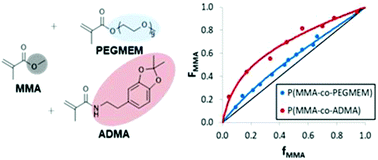Understanding copolymerisation kinetics for the design of functional copolymers via free radical polymerisation†
Abstract
Determining the monomer sequence distribution of copolymers is important when correlating copolymer molecular structure (random, gradient etc.) to macroscopic/material properties. We report here the relative monomer reactivities for the copolymerisation of methyl methacrylate (MMA) with functional monomers – poly(ethylene glycol) methyl ether methacrylate (PEGMEM Mn 500 g mol−1), acetonide-protected dopamine methacrylamide (ADMA), methacrylic acid (MAA) and glycidyl methacrylate (GMA) – to provide information on monomer sequence distribution and compositional drift. Reactivity ratios were calculated, using non-linear least squares regression analysis, in the cases of the free radical copolymerisation of MMA with (i) PEGMEM (rMMA = 1.17 rPEGMEM = 0.62) and (ii) ADMA (rMMA = 2.21 rADMA = 0.17). Additionally, monomer feed depletion as a function of total monomer conversion was monitored by 1H NMR spectroscopy for a series of batch co- and terpolymerisations. This approach offers detailed insight into monomer compositional drift and copolymerisation kinetics. Such information provides a platform for the design of copolymers with specific desired properties e.g. adhesion, solubility or interfacial activity.



 Please wait while we load your content...
Please wait while we load your content...